While most audiologists realize that exposure to power tool noise while wood working can be hazardous to your hearing, there are still others that are not convinced. Often they feel that they have been exposed to noise for such a long time more exposure it will not make much difference. Since there is already a hearing loss so….“So what, a little more noise will not make it that much worse and I hate those earplugs anyway!” Of course, this is the wrong idea as we know that further damage can not only impair hearing but can make tinnitus worse and possibly has other complications.
A few weeks ago, Pete Alman, a self-proclaimed “carpenter turned writer” approached Hearing International with an idea for an article on woodworking and noise exposure. Acoustics presented here are his interpretation to his colleagues as woodworkers and his hearing protection device suggestions are simply his recommendations. Suggestions carpenters from a colleagues will often be seriously considered by those exposed to noise rather than suggestions from an audiologist. The products presented here are purely his recommendations from years of protecting his hearing while woodworking and no scientific data are included for comparison or contrast. Here is Pete’s take on woodworking, the noise it generates and hearing protection from a carpenter’s point of view.
–RMT
If you are woodworking, you need to protect your hearing. However, not every set of hearing protection you see when you’re shopping around is going to protect you equally. Depending on the fact that every pair of muffs or earplugs is as good as the next is a great way to leave your ears under protected.
Luckily, there are a lot of choices when it comes down to finding the best hearing protection to use while you work.
Why Is Hearing Protection Important When Woodworking?
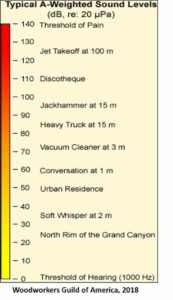 The first thing you need to know is that hearing protection isn’t optional. You shouldn’t try to skip out or “be tough” in the place of hearing protection. Sound is measured in decibels. The major points on the scale are 0 decibels which is the threshold of hearing and 140 decibels is the threshold for pain. This doesn’t mean you should only worry about sounds that are around 140 decibels. In fact, you can experience hearing loss at extended exposure to sounds at a level of 90 decibels. These numbers don’t mean much if you are only casually familiar with decibel measurement. Instead, it’s important to explain these levels via comparison.
The first thing you need to know is that hearing protection isn’t optional. You shouldn’t try to skip out or “be tough” in the place of hearing protection. Sound is measured in decibels. The major points on the scale are 0 decibels which is the threshold of hearing and 140 decibels is the threshold for pain. This doesn’t mean you should only worry about sounds that are around 140 decibels. In fact, you can experience hearing loss at extended exposure to sounds at a level of 90 decibels. These numbers don’t mean much if you are only casually familiar with decibel measurement. Instead, it’s important to explain these levels via comparison.
Putting these numbers in perspective, rustling leaves are measured at about 10 decibels. Once you get up to 90 decibels, you are looking at a sound level of a tractor or an electric drill. By the time you get to 140 decibels and higher, these are sounds such as a plane taking off. Even higher than that are fireworks, a cap gun, a balloon pop, or gunshots. To put this into the context of woodworking, there are a lot of sounds in a shop or even in your garage that can be damaging. A benchtop planer recently reviewed by Toolsy can put off sounds at levels of 105 to 110 decibels. Even a handheld router offers 95 to 115 decibels. The Occupational Safety and Health Administration (OSHA) recommends that hearing protection be used for any prolonged exposure to sounds at 85 decibels.
Hearing Loss Prevention: 5 Carpenter Recommended Hearing Protection Options
Now that you know why hearing protection is important, let’s take a look at some of your best options.
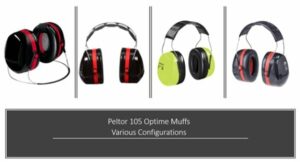 1. Peltor Optime 105 Earmuffs
1. Peltor Optime 105 Earmuffs
The first option for hearing protection is the Peltor Optime. Depending on your preference, you can get these earmuffs in a few different forms. There is the standard over-the-head option, a pair of folding-adjustable muffs, behind-the-head earmuffs, and helmet attachable earmuffs. When it comes to sound measurements, these earmuffs have a noise reduction rating of 30 decibels. This can bring that 115 decibel handheld router down to a safer level of 85 decibels. These are designed for more than just function, though, they are also made to be comfortable. The twin-cup design are meant to form around your ears. For added comfort, woodworkers can depend on the thick padding around the cups.
2. 3M Worktunes Wireless Hearing Protection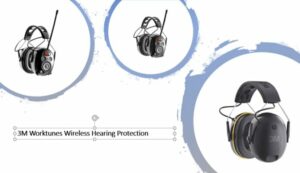
If you are interested in an earmuff style of protection, the Worktunes Wireless Hearing Protection offers that and more. First, the basics are a noise reduction rating of 24 decibels. The Worktunes are also made for comfort as they are vented for heat release and optional padding. The real difference is that these earmuffs have a built in AM/FM radio that saves up to 50 stations. They even offer enhanced radio performance to ensure you get a clear sound while you work. You can even use its audio assist technology to adjust settings without having to remove the earmuffs. If you are thinking that this defeats the purpose of protecting your ears from sound, don’t worry. The sound level of the radio automatically adjusts if it gets too loud for ear safety. These are also wireless but do require a pair of AA batteries.
3. SensGard SG-2G Hearing Protection Band
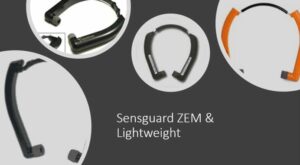 Maybe bulky hearing protection is not what you’re looking for and that’s okay; there are other options. One such option are the SensGard SG-2G hearing protection band. Instead of working as full earmuffs, these fit more like earbuds as in-the-ear protection. They are made to be able to be easily worn around the neck and slipped into the ears when working. These are also made to stay in your ears as you work, so you don’t have to worry about fighting with them while you try to finish a project. For sound, these aren’t lacking in how they protect you just because they aren’t earmuffs. The noise reduction rating for these is a decrease of 26 decibels. They are meant to help block out harmful noise but not prevent you from hearing someone speaking to you.
Maybe bulky hearing protection is not what you’re looking for and that’s okay; there are other options. One such option are the SensGard SG-2G hearing protection band. Instead of working as full earmuffs, these fit more like earbuds as in-the-ear protection. They are made to be able to be easily worn around the neck and slipped into the ears when working. These are also made to stay in your ears as you work, so you don’t have to worry about fighting with them while you try to finish a project. For sound, these aren’t lacking in how they protect you just because they aren’t earmuffs. The noise reduction rating for these is a decrease of 26 decibels. They are meant to help block out harmful noise but not prevent you from hearing someone speaking to you.
4. ISOtunes Pro Bluetooth Earplug Headphones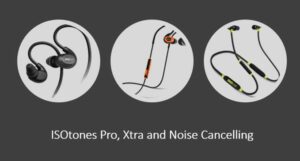
For those who preferred the earmuffs with a radio connection but aren’t a fan of the earmuff style, you don’t have to worry! The ISOtunes Pro Bluetooth Earplug Headphones help block sound and stay comfortable with a noise reduction rating of 27 decibels and a choice between silicone or memory foam eartips. The special note for these is that you can connect your device to them via bluetooth. This means that up to 30 feet away, you can listen to your music or take calls.
5. Howard Leight Disposable Foam Earplugs
 A final choice in hearing protection are earplugs. This is a type of protection that completely sits in your ear – there is no outside connection. If you are more pleased with ear protection that has a connection, you can order corded versions of these as well. The first thing to address that these are disposable. As such, you might be concerned if you are a professional or frequent woodworker. While that argument stands and these might not be the best choice for you, it also possible to buy these in bulk. The noise reduction rating on these earplugs is an impressive 32 decibels. They’re also comfortable mostly due to the fact that they’re soft and malleable so they can be folded to fit you specifically. It is, however, difficult to hear others when using this type of protection.
A final choice in hearing protection are earplugs. This is a type of protection that completely sits in your ear – there is no outside connection. If you are more pleased with ear protection that has a connection, you can order corded versions of these as well. The first thing to address that these are disposable. As such, you might be concerned if you are a professional or frequent woodworker. While that argument stands and these might not be the best choice for you, it also possible to buy these in bulk. The noise reduction rating on these earplugs is an impressive 32 decibels. They’re also comfortable mostly due to the fact that they’re soft and malleable so they can be folded to fit you specifically. It is, however, difficult to hear others when using this type of protection.
EPILOG: While these are Pete’s recommendations, there are lots of other choices for hearing protection, these are from a long time carpenter that uses them routinely in the shop and on the commercial jobs. For specific advise on hearing protection for woodworking or hearing protection in other situations where noise may be a health hazard, consult your local audiologist as he or she will have numerous options such as other brands of muffs, plugs, custom made products and other solutions.
Guest Author:
 Hi there, I’m Woodworking Pete Alman. I’m a former carpenter turned writer, and proud resident of Nashville, Tennessee. Over the years, I’ve been working on multiple – both in-house and external projects for a multitude of varying clients and businesses. Things like putting together mock-ups of rustic kitchen cabinetry from the grounds up, selecting and evaluating materials (including material cost) for defects and repair, following strict guidelines (finish carpentry, rough carpentry), and working with a variety of power tools such as a miter saw, skill saw, and jigsaw as per all woodworking safety standards. During which, I’ve also used hearing, eye, and mouth protection (debris) according to strict regulations and carpentry protocol. My favorite hearing protection would be the Peltor Optime 105. When not working on a project in my shed, I’m lifting weights or hanging out with my three dogs (Dobermans).
Hi there, I’m Woodworking Pete Alman. I’m a former carpenter turned writer, and proud resident of Nashville, Tennessee. Over the years, I’ve been working on multiple – both in-house and external projects for a multitude of varying clients and businesses. Things like putting together mock-ups of rustic kitchen cabinetry from the grounds up, selecting and evaluating materials (including material cost) for defects and repair, following strict guidelines (finish carpentry, rough carpentry), and working with a variety of power tools such as a miter saw, skill saw, and jigsaw as per all woodworking safety standards. During which, I’ve also used hearing, eye, and mouth protection (debris) according to strict regulations and carpentry protocol. My favorite hearing protection would be the Peltor Optime 105. When not working on a project in my shed, I’m lifting weights or hanging out with my three dogs (Dobermans).
References:
Keller, S (2018). Hearing protections for the woodshop. Woodworkers guild of America. Retrieved November 13, 2018.








Great Post About Woodworking Thanks for sharing!